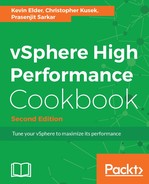A vCPU is in a ready state when the vCPU is ready to run (that is, it has a task it wants to execute). But it is unable to run because the vSphere scheduler is unable to find physical host CPU resources to run the VM on. One potential reason for elevated ready time is that the VM is constrained by a user-set CPU limit or resource pool limit, reported as max limited (MLMTD). The amount of CPU denied because of a limit is measured as the metric max limited.
Ready time is reported in two different values between resxtop/esxtop and vCenter Server. In resxtop/esxtop, it is reported in an easily understood percentage format. A figure of 5 percent means that the VM spent 5 percent of its last sample period waiting for the available CPU resources (only true for 1-vCPU VMs). In vCenter Server, ready time is reported as a measurement of time. For example, in vCenter Server's real-time data, which produces sample values every 20,000 milliseconds, a figure of 1,000 milliseconds is reported for 5 percent ready time. A figure of 2,000 milliseconds is reported for 10 percent ready time.

Although high ready time typically signifies CPU contention, the condition does not always warrant corrective action. If the value of ready time is close in value of the amount of time used on the CPU and if the increased ready time occurs with occasional spikes in CPU activity but does not persist for extended periods of time, this might not indicate a performance problem. The brief performance hit is often within the accepted performance variance and does not require any action on the part of the administrator.
